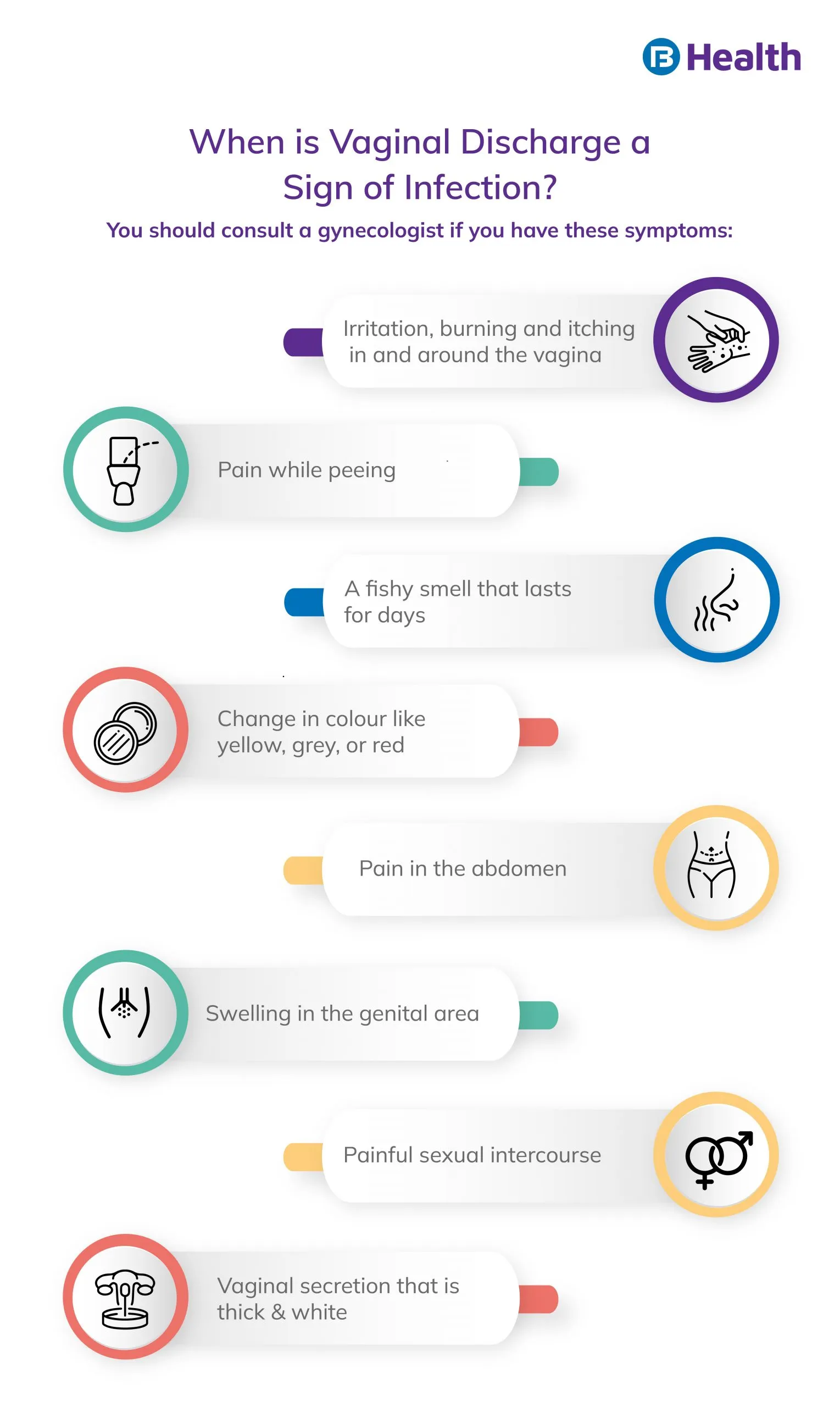Gynaecologist and Obstetrician | 5 min read
Vaginal Discharge: Meaning, Symptoms, Types and Diagnosis
Medically reviewed by
- Table of Content
Synopsis
Women often feel uncomfortable talking about vaginal discharge. Although, it is natural and keeps the vagina clean and infection free. The colour, odour, and texture of fluid may differ depending on age and especially during menstruation. However, some change indicates the need for medical attention. Read further to know the white discharge reason, its causes and treatment.
Key Takeaways
- Normal vaginal discharge is clear white fluid without any odour
- Vaginal discharge and secretion usually increase before menstruation
- Vaginal discharge does not cause any harm, infection or itching
What is Vaginal Discharge?
The vaginal discharge is the secretion of white fluid from the vagina, uterus, and cervix. It is made up of liquid and bacteria. This white liquid keeps the vagina clean, healthy and reproductive. The amount of discharge may differ from person to person. The colour and consistency may change each day, particularly on menstrual days.
The white liquid consists of both good and bad bacteria. The good bacteria keep everything in control. However, infection occurs when one kind of bacteria grows out of control. The musky odour, colour, and texture indicate an underlying health condition. Treatment and medical attention can resolve abnormal vaginal discharge successfully.
Color of Vaginal Discharge
As already discussed, vaginal discharge is a white, clear fluid. However, colour discharge points to a health condition.
Yellow – Green
The slight yellow colour may not be a problem. It likely occurs due to changes in dietary supplements. However, if the discharge turns to darker yellow or yellowish green, it indicates a bacterial attack called sexually transmitted infection (STI). [1]
Red
The red vaginal discharge, except in menstrual periods, indicates a health problem. Anyone suffering from Amenorrhea for a long time and experiencing sudden vaginal bleeding must see a doctor.
Gray
The grey discharge indicates a health problem called bacterial vaginosis. Itching and unpleasant smell are other symptoms associated with it. Meet the doctor immediately if someone suffers from this.
Additional Read: Polymenorrhea Causes and Treatment
What is Considered Normal Vaginal Discharge?
The normal vaginal discharge is clear, white fluid without smell, whereas thickness may differ during periods.
Color: Milky white, clear and off-white are natural. However, specific colours like grey, green, dark yellow and red indicate certain infections.
Odor: Usually, the vaginal discharge has a mild odour but doesn't smell unpleasant. Although if you experience a musky, fishy odour associated with a texture change, it indicates a health issue.
Texture: The normal fluid is watery, sticky, pasty and thicky. Although a foamy appearance associated with smell and itching signals an infection.
Amount: The amount differs from person to person, and other factors like ovulation and pregnancy may affect it. Although a sudden increase in vaginal secretion is a matter of attention.
It is common to have white discharge after a period. It prevents vaginal dryness and keeps the vaginal moist. Although unbearable pain, itching in and around the vagina needs immediate medical care.
Causes of Vaginal Discharge
Vaginal discharge is normal in women's bodies. It occurs to keep the vagina healthy. The white discharge reason may make you anxious. Although knowing the cause helps treatment. The change in estrogen level causes the white discharge. The fluctuation in the estrogen level is normal. The level rise during puberty and automatically declines as you reach menopause. During periods you may encounter pain and cramps. This condition is referred to as dysmenorrhea. It happens due to a high level of estrogen. [2]
The amount of discharge may vary during ovulation, pregnancy, and sexual arousal. A rise and fall in estrogen levels happen throughout this time. In pregnant ladies, Preeclampsia is witnessed. In this condition, a significant decline in estrogen levels was observed, affecting vaginal discharge. [3]
Additional Read: Low Estrogen LevelsWhen is Vaginal Discharge a Sign of Infection?
The vaginal discharge alone doesn't give enough evidence. Although, there are symptoms that help to be sure.
- Irritation, burning and itching in and around the vagina
- Pain while peeing
- The fishy smell lasts for days
- Change in colour like yellow, grey, or red
- Pain in the tummy area
- Swelling in the genital area
- Painful sexual intercourse
- The vaginal secretion that looks like cottage cheese
It is good to consult a gynaecologist if the symptoms appear after unprotected sex.
Types of Vaginal Discharge
The vaginal discharge is categorised based on colour, odour, and consistency. Here are a few types of vaginal discharge.
Milky white:
White colour discharge is healthy and occurs at the beginning or end of the menstrual cycle.
Yellow or Green:
Darker yellow or green fluid with foul odour signals sexually transmitted infection.
Bloody:
The red vaginal discharge may indicate a health condition. Talk to the doctor without fail.
Clear watery:
Clear discharge signals ovulation, hormonal imbalance, or pregnancy.

Vaginal Discharge Diagnosis
If you are suffering from any vaginal issues, bring the condition to the Gynaecologist's attention. The doctor may ask about symptoms, menstrual cycle, and lifestyle changes. The patient may need to go through a physical and pelvic exam for more evidence.
In some cases, the doctor may also suggest a swab test to find evidence of infection.
Vaginal Discharge Treatment
The white discharge is normal. Here is a few white discharge treatment to reduce the risk of infection.
- Wash around the vagina with water. Avoid using vagina spray and scented products
- Try to urinate after sexual intercourse to avoid urinary infection
- Touch the vaginal area with clean hands
- Avoid using cleansers for the intimate area until the doctor prescribes
- During periods, change tampons and pads frequently
- Consider cotton underpants to keep the vaginal area cool and irritation free
- Use condoms during sexual activity
- Maintain a healthy lifestyle to reduce the risk of infection
- If you are diagnosed with an infection, have medicine as the doctor prescribed and avoid self-medication
Your body often signals about health conditions. Vaginal discharge similarly can tell you a lot about your health. Women may feel shy to talk openly about this. Although, hiding a situation will make the treatment more difficult. Hence it is always good to take the doctor's advice as soon as possible. Visit Bajaj Health Finserv to get more information or the answers to any queries you might have. If you are still hesitant to visit a doctor directly, get an online doctor consultation from any location at your convenience.
- References
- https://pubmed.ncbi.nlm.nih.gov/17524189/
- https://www.ncbi.nlm.nih.gov/pmc/articles/PMC2099568/#:~:text=Trichomonas%20vaginalis%20can%20cause%20an,but%20many%20patients%20are%20asymptomatic.&text=This%20infection%20is%20associated%20with%20preterm%20delivery.
- https://www.ncbi.nlm.nih.gov/pmc/articles/PMC7136476/
- Disclaimer
Please note that this article is solely meant for informational purposes and Bajaj Finserv Health Limited (“BFHL”) does not shoulder any responsibility of the views/advice/information expressed/given by the writer/reviewer/originator. This article should not be considered as a substitute for any medical advice, diagnosis or treatment. Always consult with your trusted physician/qualified healthcare professional to evaluate your medical condition. The above article has been reviewed by a qualified doctor and BFHL is not responsible for any damages for any information or services provided by any third party.




